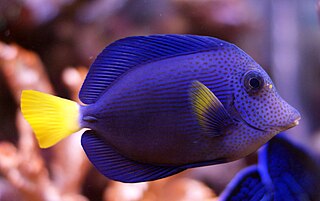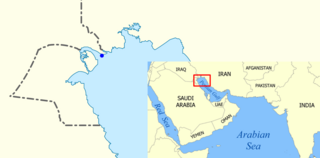
Eleotridae is a family of fish commonly known as sleeper gobies, with about 34 genera and 180 species. Most species are found in the tropical Indo-Pacific region, but there are also species in subtropical and temperate regions, warmer parts of the Americas and near the Atlantic coast in Africa. While many eleotrids pass through a planktonic stage in the sea and some spend their entire lives in the sea; as adults, the majority live in freshwater streams and brackish water. One of its genera, Caecieleotris, is troglobitic. They are especially important as predators in the freshwater stream ecosystems on oceanic islands such as New Zealand and Hawaii that otherwise lack the predatory fish families typical of nearby continents, such as catfish. Anatomically, they are similar to the gobies (Gobiidae), though unlike the majority of gobies, they do not have a pelvic sucker.
Collared wrigglers are perciform fishes in the family Xenisthmidae. They are native to the Indian and Pacific Oceans, where they are mostly reef-dwelling.

The grey sharpnose shark, Rhizoprionodon oligolinx, is a requiem shark of the family Carcharhinidae. It is found in the tropical waters of the Indo-West Pacific Oceans, between latitudes 30° N and 18° S, from the surface to a depth of 36 m. It can reach a length of about 70 cm.

The pennant coralfish, also known as the longfin bannerfish, reef bannerfish or coachman, is a species of fish of the family Chaetodontidae, native to the Indo-Pacific area.

The Arabian carpetshark is a species of carpet shark in the family Hemiscylliidae, inhabiting coral reefs and other shallow coastal habitats from the Persian Gulf to India. Reaching 78 cm (31 in) long, this shark is characterized by a slender, plain brown body, and by two dorsal fins with straight trailing margins and the second smaller but longer-based than the first. The Arabian carpetshark feeds on bony fishes and invertebrates. Reproduction is oviparous with an annual cycle; females deposit egg capsules four at a time and the young hatch after 70–80 days. This small shark is often captured as bycatch but rarely used by humans. It has been assessed as Near Threatened by the International Union for Conservation of Nature (IUCN), as there is increasing fishing pressure and habitat degradation within its range. It does well in aquariums and has been bred in captivity.

The slender whiting is a poorly known species of inshore marine fish of the smelt whiting family, Sillaginidae that has a distribution limited to the Persian Gulf only. The Slender whiting, like most sillaginids requires careful study to determine its identity, with ray and vertebrae counts as well as swim bladder morphology distinguishing features. This inshore species of fish is commonly taken by fishermen using beach seines and is sold fresh in local markets.

Zebrasoma xanthurum, the purple tang or yellowtail tang, is a species of marine ray-finned fish belonging to the family Acanthuridae which includes the surgeonfishes, unicornfishes and tangs. This species is endemic to the north western Indian Ocean.
Antennablennius simonyi, Simony's blenny, is a species of combtooth blenny found in the western Indian Ocean, from the Gulf of Aden to the Persian Gulf.
Xenisthmus polyzonatus is a species of fish in the Xenisthmidae (wriggler) family, which is regarded as a synonymous with the Eleotridae... It is found in the Indo-Pacific, from the Red Sea to Samoa, north to the Ryukyu Islands.

Xenisthmus is the most well-known genus in the family Xenisthmidae, which is regarded as a synonymous with the Eleotridae, a part of Gobiiformes. These small to very small fish are known as wrigglers, and live in reefs and among rubble in the Indo-Pacific.
Rotuma lewisi, or Lewis's wriggler, is a species of fish in the family Xenisthmidae, which is regarded as a synonymous with the Eleotridae. Rotuma is a monotypic genus. The generic name refers to the volcanic island of Rotuma, north of Fiji while the specific name honours Anthony D. Lewis, a Fisheries Officer of the Government of Fiji who supported Springer's field work in Fiji. It has been recorded from Fiji, Tonga, the Santa Cruz Islands, the Comoros Islands, and the Chesterfield Islands.
Xenisthmus africanus, also known as the flathead wriggler or African wriggler, is a species of fish in the Xenisthmidae (wriggler) family, which is regarded as a synonymous with the Eleotridae,. It is found in the Indian Ocean, ranging from the coast of east Africa and to the islands in the western Indian Ocean. It has a flatter head than most other wrigglers.

Xenisthmus clarus, better known as the clear wriggler, is a species of fish in the Xenisthmidae (wriggler) family, which is regarded as a synonymous with the Eleotridae.
Xenisthmus chi is a species of fish in the wriggler family, Xenisthmidae, which is regarded as a synonymous with the Eleotridae,. Japan wrigglers are tiny and clear. Before Paedocypris progenetica and the dwarf goby were discovered, the Japan wriggler was the smallest known fish.

The pita skate is a medium-sized skate in the family Rajidae. The holotype and only known specimen was found in the northern Persian Gulf, in Iraqi waters. It was collected at a depth of less than 15 m (49 ft).
Paraxenisthmus springeri is a species of fish in the genus Paraxenisthmus of the Xenisthmidae (wriggler) family, which is regarded as a synonymous with the Eleotridae, from the West Pacific. Its specific name honours the American ichthyologist Victor G. Springer of the U.S. National Museum for his contributions to fish systematics.
Xenisthmus eirospilus, the spotted wriggler, is a species of fish in the wriggler family, Xenisthmidae, which is regarded as a synonymous with the Eleotridae,. It is distributed in the western Pacific from Middleton Reef and Ashmore Reef off Australia, West Papua, Indonesia, to Rotuma and Tonga. Its habitat is sand patches among reefs and rubble, as well as in shallow surge areas.
Xenisthmus semicinctus, the halfbelt wriggler, is a species of fish in the wriggler family, Xenisthmidae, which is regarded as a synonymous with the Eleotridae,.
Xenisthmus chapmani is a species of goby from the sleeper goby family Eleotridae which is known from a single specimen collected in Espiritu Santo Harbour, Vanuatu. Its specific name honours Dr. Wilbert M. Chapman the collector of the holotype.

Epinephelus stoliczkae, the epaulet grouper, is a tropical fish species in the family Serranidae and in the genus Epinephelus.









